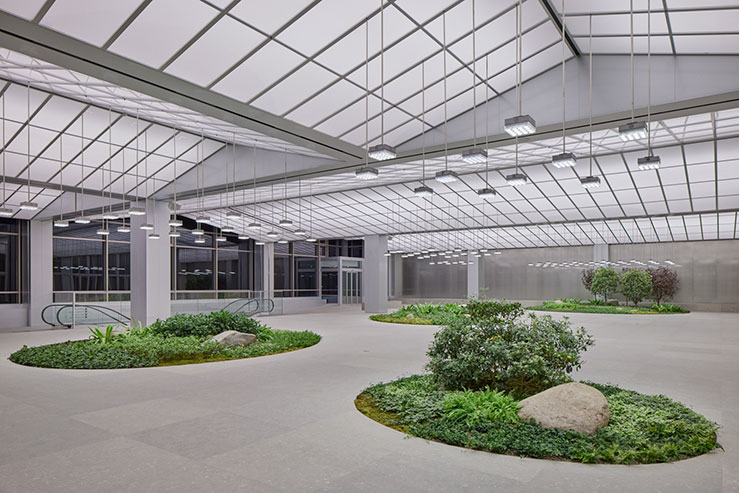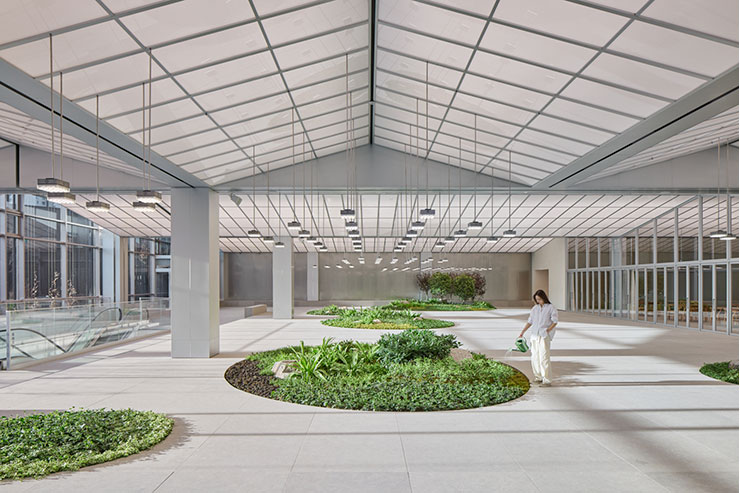This website uses cookies so that we can provide you with the best user experience possible. Cookie information is stored in your browser and performs functions such as recognising you when you return to our website and helping our team to understand which sections of the website you find most interesting and useful.
Garden Conservatory, Republic of Korea
ProjectGarden ConservatoryLocationSeoul, Republic of KoreaLighting DesignLichtvision, UKArchitectCasper Mueller Kneer Architects, UKClientHyundai Department StoreLighting SuppliersReggiani, Lluria
The Hyundai Department Store Mokdong in Seoul features the world’s most famous luxury brands. While all senses are challenged in the shopping section, the top floor offers space to rest. The minimalist “Glass House Garden Room” serves as the entrance floor to the surrounding residential towers and can be used for events or exhibitions. Above all it offers a place of tranquillity for visitors of the department store. The space is visually divided by green islands of plants. Plant-friendly LED lights above each island enhances both human and plant well-being.
A place of recreation
Casper Mueller Kneer Architects and Lichtvision Design have designed the space as a contemporary interpretation of the traditional green house and transformed it into an oasis right in the heart of the city. They have already realised various areas of other Hyundai stores in Seoul.
In Mokdong, the surrounding roof terrace on the seventh floor was extended into the interior – daylight, however, only enters the room through the side windows. Although the ceiling is modelled after a greenhouse roof, its panels are artificially backlit. The actual ceiling above is flat and does not let in any daylight. Therefore, it was necessary to develop a lighting solution that fosters the healthy development of the plants and at the same time improves human well-being.
Swarms of biophilic luminaires
To accentuate the plant islands embedded in the floor of the purist room and to supply them with light suitable for plants, suspended luminaires were used. These were to float above the plants like swarms of diffuse luminous clouds.
Based on the spaces’ architectural style, Lichtvision implemented this idea with industrial-looking luminaires in a raw aluminium finish. For the artificial lighting design, principles from biophilic design were used, which seeks to harmonise architecture with nature and places people at the centre.
Indoors, artificial light should ideally compensate for the lack of natural light in the best possible way. Based on current research results, Lichtvision chose LED luminaires with a colour temperature of 4,000 Kelvin, good colour rendering and increased light levels – as an optimal compromise in light quality and quantity, both for human and for plant physiology.
The red-light component of the LED chips used is reduced – to avoid the stimulation of a fast and stressful growth for the plants. In addition, the illuminance was selected to meet plant needs while avoiding glare and taking operating costs into account.
Sustainable light for well-being
The “Glass House Garden Room” combines minimalism, light suitable for plants and industrial design. It makes light a protagonist – even though it only diffusely illuminates its surroundings.
The unique project is Lichtvision’s starting point for further biophilic design concepts that focus on human well-being and adds new nature-oriented approaches to indoor ornamental plant lighting. It is thus an important milestone for the design studio to evaluate the latest research results in practice, to help steer future developments and to be able to meet challenges such as sustainability even better in the future.






